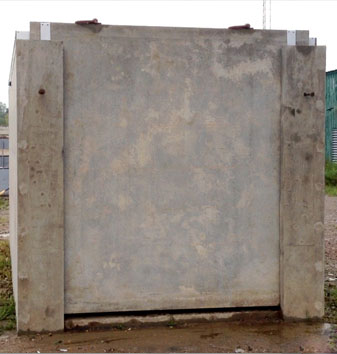

Industrial Storage & Security

Overview
Many construction sites are linear in nature. Pipelines, highways, power transmission lines and other similar types of heavy construction present unique challenges to the contractors who must actually build these projects. One of these challenges centers on the issue of on-site asset management. The equipment and supplies that the contractor uses to complete his project are usually quite expensive. Logistics requires the contractor to try to store supplies and equipment on-site where it is nearby and convenient when it is needed. Over time, however, jobsite theft has become a significant problem, placing logistical demands on the contractor as he tries to balance the necessity of having his supplies and equipment close by with the risk of jobsite loss. In addition to the direct financial cost due to the loss of assets through theft, the expenses, hidden and explicit, related to delays and interruptions to the workflow can be significant.
The typical solution for most contractors today is to store more expensive items in steel containers like those used for transoceanic shipping. These units are easily transported and sturdy. However, their weakness lies in their access doors that are located at their ends. These doors are secured with some type of lock. Most locks are vulnerable to thieves who, with bolt cutters or blow torches can easily gain access to the containers. Thus, although these containers are good for storing some items, they are unreliable for the storage of more expensive supplies and equipment. Often, the contractor is forced to haul these items in to his job site each day and haul them out again at the end of the day, essentially mobilizing and de-mobilizing the job daily. The other primary alternative for the contractors is to hire security personnel for off-hours. Except for short-duration projects, however, hired security becomes prohibitively expensive.
A new alternative is now proposed: the SafeBox®
Concept
The SafeBox· is an elongated prestressed concrete box that comprises individual panels that are assembled at the manufacturing plant. The concrete materials used in the construction of the SafeBox will give it the qualities of being highly durable, tough, waterproof, rot proof, vermin proof, and highly table. It will provide safe harbor to employees during dangerous weather, and it will be virtually impenetrable by unauthorized personnel. It will be easily loaded onto equipment trailers for quick movement among jobsites where it will not have to be connected to utilities nor set up as a permanent structure. Once set at a jobsite, the SafeBoxllD can hold signage for the Contractor that establishes his community presence. Although primarily to be used for the secure storage of equipment and supplies, the SafeBoxllD will also be equipped with other features that are valuable to the Contractor as outlined below.
Features
- Prestressed concrete construction - The SafeBox is constructed of prestressed concrete panels. Prestressing concrete is a process used in the construction industry that enables concrete members to span long distances while taking advantage of the strength, integrity, and economics of Portland cement concrete. Prestressed concrete uses very high strength steel tendons that induce large compressive forces into the members. The use of these tendons is a contributing factor to the toughness of the SafeBoxllD • Additional penetration resistance is to be obtained by the addition of steel fibers to the constituent concrete.
- End slab - All of the constituent panels will be welded together as part of the SafeBox's construction. However, access to the interior will be gained through the end of the unit by way of the unwelded end slab, which will slide vertically to allow access to a secondary door that is part of a welded wire fabric (WWF) wall. The end slab provides near-absolute security during off-hours, but it can be raised to allow access to the WWF door that allows easy, yet controlled access by authorized personnel during work hours. The end slab will have a lift mechanism to raise it when needed. The mechanism will be operated by an electronic control device the uses a code. As need arises, the code may be changed for security reasons. The door will be equipped with a GPS sending unit that will notify a monitoring service should movement of the door, and by extension the whole SafeBox, occur during unauthorized hours. Should mechanical failure occur, the end slab may be raised by means of a piece of lifting equipment, such as a crane. Thus, a certain amount of redundancy will exist such that the SafeBox will be usable at all times by authorized employees.
- Interior tool and supply storage - The SafeBox will be equipped with industrial shelving that can accommodate heavy tools and supplies. Certain sections of the floor area can be reserved for open storage of bulky items. Other sections can have steel dividers that can help organize long handled tools or items of equipment.
- First Aid Station - The SafeBox will come equipped with a small first-aid station. This feature will include a jobsite eyewash station in addition to the normal safety supplies needed for a construction site. Also included as a part of this station will be some basic survival supplies for longer-term emergencies.
- Bulletin Boards - An internally mounted bulletin board will be fastened to the wall to provide a location for company-related announcements and emergency contact information. On the exterior wall will be special fasteners that will accommodate several small external bulletin boards. These boards are required by the state for dissemination of certain labor-related issues and safety notifications. The fasteners will allow for the quick and easy dismounting of these boards such that they can be safely stowed during the off-hours.
- Weather Station - located within the unit and up near the ceiling will be a battery-operated weather station. This station will constantly monitor and record the weather data at the jobsite. This information can be invaluable to the Contractor as he tracks the job's progress. A means of transmitting the data to the internet for remote monitoring is also planned.
- Security Cameras - This option would provide for the presence of two or more security cameras that would monitor the area around the SafeBox®. This area typically would be the staging area for the Contractor, which is the area where theft and vandalism is most likely to occur. Thus, the Contractor may be able to monitor the jobsite remotely via the internet.
- Solar Panel - To power the door panel lifting device, the weather station, security cameras, and GPS emitters, a solar cell array will be fixed into the roof panel. This array will constantly recharge a battery that will then keep the various systems powered.
